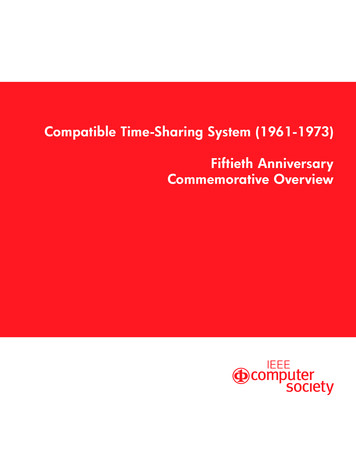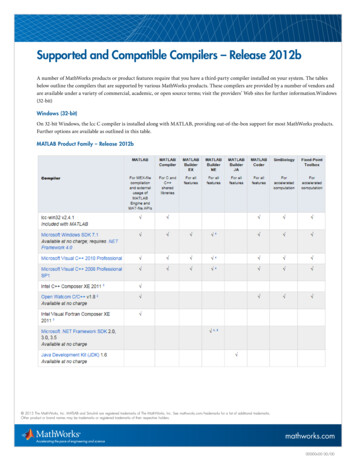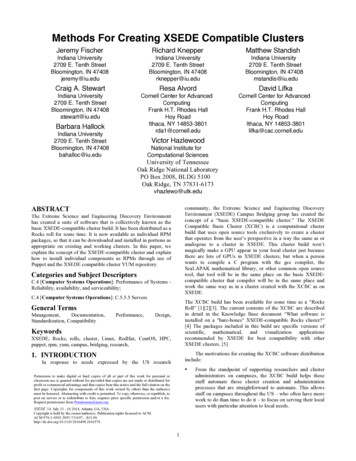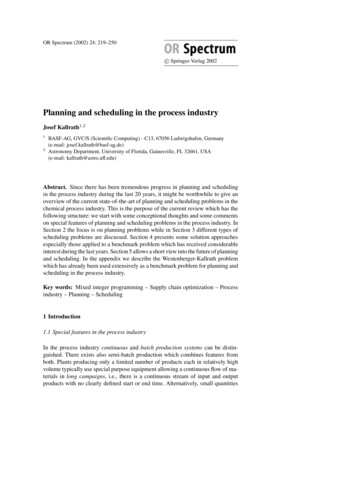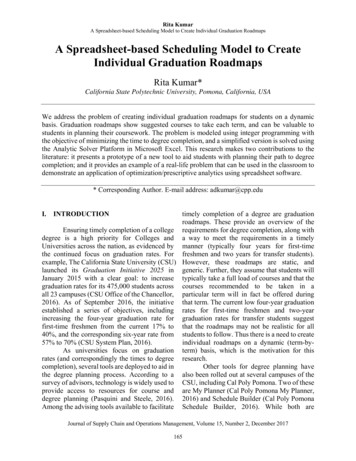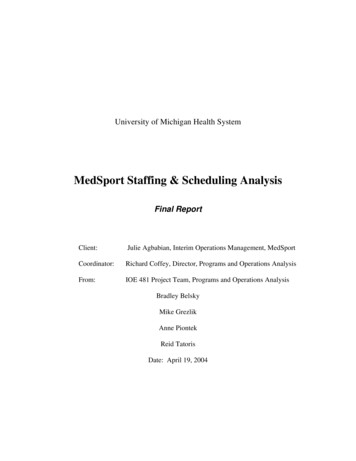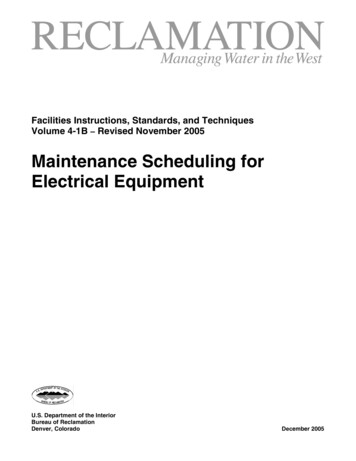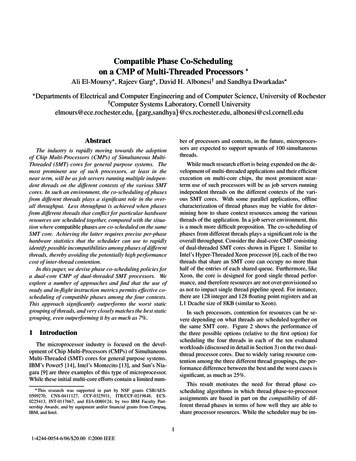
Transcription
Compatible Phase Co-Schedulingon a CMP of Multi-Threaded Processors Ali El-Moursy , Rajeev Garg , David H. Albonesi and Sandhya Dwarkadas Departments of Electrical and Computer Engineering and of Computer Science, University of RochesterComputer Systems Laboratory, Cornell Universityelmours@ece.rochester.edu, garg,sandhya @cs.rochester.edu, albonesi@csl.cornell.edu Abstractber of processors and contexts, in the future, microprocessors are expected to support upwards of 100 simultaneousthreads.The industry is rapidly moving towards the adoptionof Chip Multi-Processors (CMPs) of Simultaneous MultiThreaded (SMT) cores for general purpose systems. Themost prominent use of such processors, at least in thenear term, will be as job servers running multiple independent threads on the different contexts of the various SMTcores. In such an environment, the co-scheduling of phasesfrom different threads plays a significant role in the overall throughput. Less throughput is achieved when phasesfrom different threads that conflict for particular hardwareresources are scheduled together, compared with the situation where compatible phases are co-scheduled on the sameSMT core. Achieving the latter requires precise per-phasehardware statistics that the scheduler can use to rapidlyidentify possible incompatibilities among phases of differentthreads, thereby avoiding the potentially high performancecost of inter-thread contention.In this paper, we devise phase co-scheduling policies fora dual-core CMP of dual-threaded SMT processors. Weexplore a number of approaches and find that the use ofready and in-flight instruction metrics permits effective coscheduling of compatible phases among the four contexts.This approach significantly outperforms the worst staticgrouping of threads, and very closely matches the best staticgrouping, even outperforming it by as much as 7%.While much research effort is being expended on the development of multi-threaded applications and their efficientexecution on multi-core chips, the most prominent nearterm use of such processors will be as job servers runningindependent threads on the different contexts of the various SMT cores. With some parallel applications, offlinecharacterization of thread phases may be viable for determining how to share context resources among the variousthreads of the application. In a job server environment, thisis a much more difficult proposition. The co-scheduling ofphases from different threads plays a significant role in theoverall throughput. Consider the dual-core CMP consistingof dual-threaded SMT cores shown in Figure 1. Similar toIntel’s Hyper-Threaded Xeon processor [6], each of the twothreads that share an SMT core can occupy no more thanhalf of the entries of each shared queue. Furthermore, likeXeon, the core is designed for good single thread performance, and therefore resources are not over-provisioned soas not to impact single thread pipeline speed. For instance,there are 128 integer and 128 floating point registers and anL1 Dcache size of 8KB (similar to Xeon).In such processors, contention for resources can be severe depending on what threads are scheduled together onthe same SMT core. Figure 2 shows the performance ofthe three possible options (relative to the first option) forscheduling the four threads in each of the ten evaluatedworkloads (discussed in detail in Section 3) on the two dualthread processor cores. Due to widely varing resource contention among the three different thread groupings, the performance difference between the best and the worst cases issignificant, as much as 25%.1 IntroductionThe microprocessor industry is focused on the development of Chip Multi-Processors (CMPs) of SimultaneousMulti-Threaded (SMT) cores for general purpose systems.IBM’s Power5 [14], Intel’s Montecito [13], and Sun’s Niagara [9] are three examples of this type of microprocessor.While these initial multi-core efforts contain a limited num-This result motivates the need for thread phase coscheduling algorithms in which thread phase-to-processorassignments are based in part on the compatibility of different thread phases in terms of how well they are able toshare processor resources. While the scheduler may be im- This research was supported in part by NSF grants CSR/AES0509270, CNS-0411127, CCF-0325931, ITR/CCF-0219848, ECS0225413, INT-0117667, and EIA-0080124; by two IBM Faculty Partnership Awards; and by equipment and/or financial grants from Compaq,IBM, and Intel.11-4244-0054-6/06/ 20.00 2006 IEEE
1.4IIQIRFFQDecode QIRFFQL1ICacheDecode QFFU0.2Front-endExecution EngineL1 DCache0Figure 1. Dual core CMP of partitioned dualthreaded SMT processors (FQ: Fetch Queue; IIQ:Integer Issue Queue; IRF: Integer Register File;IFU: Integer Functional Unit; FIQ: Floating Point Issue Queue; FRF: Floating Point Register File; FFU:Floating Point Functional Unit; LSQ: Load/StoreQueue).Thread0 1/2 3Thread0 2/1 3Thread0 3/1 2mix1mix2mix3mix4mix5mix6mix7mix8mix9mix10Figure 2. Overall performance for ten four-threadworkloads. For each workload, the three bars correspond to the three possible ways that the fourthreads can share the two processors.2 Related WorkThe topic of job scheduling on both uni- and multiprocessor systems has been researched for decades. However, much less attention has been paid to the subject of jobscheduling on an SMT machine. We focus the discussionin this section on related work in scheduling for SMT machines.The first body of work to address scheduling in SMTmachines was by Snavely et al. [18, 19, 20]. Their effortsfocused on a job scheduler called SOS (Sample, Optimize,Symbios) for monolithic (not partitioned, as in our microarchitecture) SMT machines. The approach uses explorationby running each thread combination for a certain interval oftime. During the sampling period, SOS gathers hardwarestatistics such as functional unit and queue conflicts. Thesubsequent optimization phase uses this information to determine the symbiosis among the threads in order to makethe best scheduling decision.Two efforts explore avoiding the high cost of explorationin the SOS approach by monitoring resource activity tomake on-the-fly SMT scheduling decisions without exploration. The thread scheduling work by Parekh et al. [15] isthe most similar to our own. They examine a variety of metrics for determining the best way to schedule threads on anSMT processor, and experimentally determine that an IPCbased thread-sensitive scheduling algorithm that schedulesthe highest IPC threads together is the best performingscheduler.Settle et al. [8, 17] use an L2 cache activity vector toenhance the Linux scheduler for SMT machines. As wediscuss in more detail in Section 5.1.1, this approach dynamically tracks the usage of the L2 cache for each threadon a set by set basis and creates per-thread cache activityvectors that indicate the most heavily utilized sets. The logical ANDing of two activity vectors creates a cache conflictplemented at a fine grain in hardware, or coarser grain insoftware (we discuss these tradeoffs in Section 6.2), hardware performance counters can be used to gather the appropriate information required to assess compatibility amongthread phases.In this paper, we explore various means for accumulating this hardware information, and its use by thread coscheduling policies, for a dual-core CMP of dual-threadedSMT processors as shown in Figure 1. We discover thatregister file and L1 data cache usage or contention are inconsistent metrics for making effective co-scheduling decisions. Rather, we find that more general information,namely the number of ready instructions, and the numberof in-flight instructions, provides a very strong indicationof thread phase compatibility, and provides a consistent result no matter how the threads are grouped when the measurement is made. Our co-scheduling policy at a fine-grainphase granularity closely matches the best static groupingof threads, and even exceeds it by as much as 7%. Perhaps more importantly, the approach avoids the significantperformance degradation of a poor static grouping of incompatible threads. Furthermore, we find that the approachworks well at a much coarser time interval, permitting thedecision function to be assumed by the operating system.The rest of this paper is organized as follows. Relatedwork is discussed in the next section, followed by our experimental methodology in Section 3. In Section 4, we presentan evaluation of resource contention in SMT processors,followed by a description of various candidate thread coscheduling policies in Section 5. Results are presented inSection 6, and we conclude in Section 7.2
vector that is used by the Linux scheduler to determine howbest to co-schedule threads on an SMT machine. Chandra etal. [3] also address L2 cache contention, but on a dual-coreCMP organization using single-threaded processors. Theypropose the analytical Inductive Probability (Prob) modelto produce a very accurate prediction of the number of extraL2 cache misses due to inter-thread contention. Fedorova etal. [5] propose a multi-threaded data locality conflict modelto estimate the L2 cache misses for co-scheduled threads.Their approach requires examining all possible combinations of threads to make a scheduling decision for a multicore multi-threaded machine.Exploration-based approaches are viable only with a limited number of thread combinations, and therefore, are inappropriate for use with the large number of SMT cores andthreads expected in the future. Moreover, although cacheconflicts can certainly be a major source of thread phasecompatibility, threads that can co-exist cache-wise may beincompatible due to serious conflicts for other resources.In a CMP of SMT processors with partitioned queues asexplored in this paper (Figure 1), the additional primarysources of inter-thread contention are the functional unitsand the register files. Unfortunately, it is very difficultto reconcile these different sources of conflict in order toachieve consistently close to the optimal grouping across avaried set of workloads. Rather, what is needed is an onlinescheduling approach that employs simple metrics to discerninter-thread phase compatibility independent of the cause ofcontention. The development and evaluation of such policies is the subject of this paper.Finally, we mention the work by Cazorla et al. [2] onSMT hardware resource allocation. This effort attempts toallocate SMT hardware resources to threads in a way thatmaximizes performance. Although their objective is different than ours (maximize performance given thread phasesthat are running together, versus determining which phasesto co-schedule), there are elements in the two approachesthat are similar, such as identifying sensitive and insensitivethreads (called “fast” and “slow” threads in [2]).Table 1. Simulator parameters for each core andthe shared L2 cache and main memory.Branch predictorBimodal predictor entriesLevel 1 table entriesLevel 2 table entriesBTB entries, associativityBranch mispredict penaltyFetch policyFetch widthFetch queue sizeInteger Issue queue sizeFP Issue queue sizeLoad/Store queue sizeIssue widthDispatch and commit widthInteger Physical RegistersFP Physical RegistersReorder Buffer SizeInteger FUsFP FUsL1 ICacheL1 ICache LatencyL1 DCacheL1 DCache LatencyL2 CacheL2 Cache latencyTLB (each, I and D)Memory latencycomb of bimodal and gshare2048102440962048, 2-way10 cyclesICOUNT.4.32 [21]32 per core32 per thread20 per thread20 per thread28 per thread6 per core6 per core128 per core128 per core512 per thread4 per core2 per core32KB, 2-way per core1 cycle8KB, 2-way per core2 cycles2MB, 8-way20 cycles128 entries, 8KB page size, fullyassociative, per thread100 cyclesfetch, issue, and load/store queues are implemented as discussed in Section 1, similar to Pentium 4’s Hyperthreadingapproach [6]. We model a CMP of two dual-thread SMTcores using our simulator, in a job-scheduling environment,i.e., where the threads are independent applications. Thememory hierarchy is modeled in significant detail, including accounting for bus contention between the L1 cachesand the unified L2 cache that is shared between the twocores. Table 1 shows the simulation parameters for eachSMT core, and the L2 cache and main memory.We model the migration of a thread from one core to theother by flushing the pipeline, invalidating the cache, andswitching the context to the other core. We arbitrarily selectone of the two threads to be switched as our experimentsindicate that selecting either one has roughly the same performance impact.3 MethodologyBefore exploring the different causes of resource contention in the next section, we discuss the methodology usedto obtain the experimental results.3.2 Benchmarks and Multi-Threaded Workloads3.1 Simulation Infrastructure and Machine ConfigurationsTable 2 lists the multi-threaded workload mixes ofSPEC2000 benchmarks used to evaluate the differentscheduling policies. The order of the benchmarks in thetable represents their order in sharing the cores for the baseline scenario. The case where the first two benchmarksshare one core while the second two share the second coreis represented in the results as P CMP 1. In P CMP 2 andP CMP 3, the first benchmark shares a core with the thirdand fourth benchmarks, respectively. Accordingly, the otherOur simulator is based on Simplescalar-3.0 [1] for theAlpha AXP instruction set. Like the Alpha 21264 [7], theregister update unit (RUU) is decomposed into integer andfloating point issue queues and register files, and a reorderbuffer (ROB).SMT support in each core has been added by replicatingthe fetch control, rename, and ROB per thread. Per-thread3
Table 2. Multi-threaded workloads.Workload ssor) are equally partitioned among the two threads(or, equivalently, shared queues in which each thread mayoccupy no more than one-half of the entries), the majormachine resources for which thread phases may contendare the functional units, register files, and cache hierarchy.This contention for resources can potentially degrade performance, but it is unclear how this impacts the optimal coscheduling of thread phases.In this section, we perform a series of experiments inwhich we individually remove the sources of contention andobserve the impact on the variation in performance with thethree different thread groupings. This provides an indication as to how well directly measuring these sources of contention can be used to guide thread co-scheduling decisions.Figures 3 and 4 present the breakdown for two representative workload mixes. The first set of three bars in each figurepresents the performance on our baseline.Benchmarks Includedmgrid, equake, vpr, galgelgcc, swim, art, lucasswim, equake, art, mgridswim, equake, mgrid, galgelperlbmk, mgrid, vpr, galgelgcc, mcf, swim, lucasgcc, mcf, art, swimswim, mesa, equake, artart, swim, galgel, applumesa, swim, galgel, arttwo benchmarks share the other core.Each individual benchmark was compiled with gcc withthe -O4 optimization and run with its reference input set.We report results for both fine-grain (100K cycles) andcoarse-grain (100M cycles) interval schemes. For bothapproaches, we fast-forward each benchmark by 4 billioninstructions. When comparing the various fine-grain approaches, we run for one 100K cycle interval before gathering performance data. This permits each of the dynamicscheduling policies to gather statistics for an interval andmake an initial pairing. We then run each benchmark for thenext 100 million instructions, and therefore report performance results from executing 100 million instructions fromeach thread (400 million instructions total) in the workloadmix. In comparing the fine and the coarse-grain schemes,after fast-forwarding, we first run for one coarse-grain interval (100M cycles) before we begin measuring performance.We then run each benchmark for 500M instructions (2B instructions in all).4.1 Register File ContentionRegister files and issue queues are relatively long latencyresources. Due to the true dependencies in the instructionstream, these resources may be occupied for very long periods of time. The contention among the threads for theseresources is very important and critical to the overall performance. Raasch et al. [16] demonstrated that providing eachthread with an equal share of the machine queues as is donein Intel P4 Hyperthreaded processors [10, 12] performs better than sharing the queue resources. Register files, on theother hand, should be shared to permit a given thread to hidethe effective cache miss latency. The second set of threebars in Figures 3 and 4 demonstrate this impact by doublingthe register file size and equally partitioning it among thetwo threads sharing a CMP, thereby eliminating any registerfile contention. Much of the difference between the performance of the different thread pairings is eliminated, indicating that the contention for register file resources with somethread groupings may be significant, although insignificantwith other groupings.3.3 MetricsAs a performance metric, we chose the geometric meanof the relative IPC ratings of the four threads: Since the metric used is a relative measure, the use of ageometric mean avoids the issue of which configuration isplaced in the numerator or in the denominator [11]. The geometric mean equally weighs a performance improvementin one thread and an identical performance degradation inanother simultaneously executing one. The harmonic meanwould overly penalize a performance degradation, while thearithmetic mean would overly reward a performance improvement. The geometric mean avoids skewing the resultsin either direction when presenting relative performance.4.2 Functional Unit ContentionIn order to evaluate the impact of functional unit (FU)contention on thread compatibility, we performed experiments in which we also (in addition to doubling and partitioning the register file) doubled the number of FUs andassigned half to each of the two threads. This in effect giveseach thread a full set of FUs for itself, removing any contention. The results are indicated by the third set of threebars, which are virtually identical to the prior set with onlyregister contention removed. Since FUs are low latency resources (in terms of the number of cycles that they are occupied by a thread) in comparison to the registers and L1Dcache blocks, contention for these resources has a lowperformance impact, showing little change in relative performance.4 Inter-Thread Resource Contention in SMTProcessorsAssuming an SMT processor in which the major queues(fetch queue, issue queues, and load-store queue in our4
Thread0 1/2 3Thread0 2/1 3Thread0 3/1 2P CMP0.2RegfileRegfile FURegfile ICache0Regfile DCacheThread0 1/2 3Thread0 2/1 3Thread0 3/1 2P CMPRegfileRegfile FURegfile ICacheRegfile DCacheFigure 4. Performance variation breakdown formix5.Figure 3. Performance variation breakdown formix1.4.3 L1 ICache ContentionThe fourth set of three bars eliminates contention forL1 ICache resources as well by artificially duplicating theICache. Due to the very small L1 ICache footprints and lowmiss rates of our applications, the ICache has a negligibleimpact on the performance variation with different threadgroupings.4.4 L1 DCache ContentionFor the fifth set of three bars, the entire L1 DCache isreplicated for each thread. As can be seen, any remaining differences in performance among the three pairings iseliminated. Like the register file, the L1 DCache is a longlatency resource and the contention for this resource is veryimportant. However, an additional factor that may makeit less important than register files is that the contention ishighly dependent on the degree to which the threads simultaneously use the same cac
focused on a job scheduler called SOS (Sample, Optimize, r-chitecture) SMT machines. The approach uses exploration byrunningeach threadcombinationfora certainintervalof time. During the sampling period, SOS gathers hardware s
